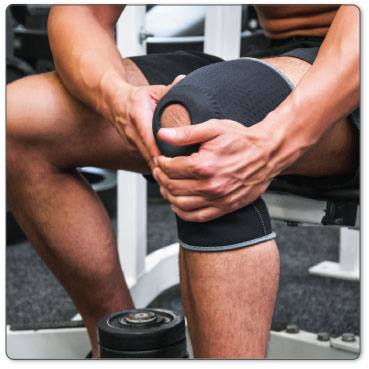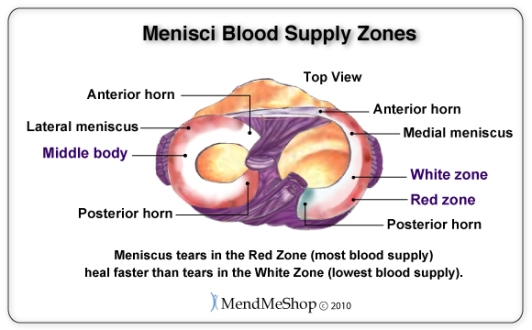(This content was initially written within a larger web-page, but it is referenced so much that it deserves its own page.)
The blood flow to the meniscus comes from the inferior genicular artery. This artery supplies blood to the perimeniscal plexus which provides oxygen and nutrients to the synovial and capsular tissues around the menisci and within the knee joint. The coronary ligaments attached to the meniscus, transport the blood from the perimeniscal plexus (network of blood vessels) into the peripheral of the menisci. The anterior and posterior horns of the menisci also receive a good amount of blood as they are covered by a vascular synovium. The interior part of the meniscus is avascular, having NO direct blood supply.

Blood supply to the injured meniscus is critical to healing! Location of the tear on the meniscus (the blood supply zone it's located in) will influence your ability to heal without surgery. The meniscus tissue is different 'fibrocartilage' than any other soft tissue in the body and has limited blood flow. This can make it difficult for the body to heal a meniscus tear on its own.
Tears in the red zone have the best chance of healing because they have more access to blood supply.

Based on blood supply, meniscus tears can be described in 3 different ways depending on the zone they're located in...
If both sides of a meniscus tear are in the red zone (the outer edge of your meniscus), your body has the ability to heal the tear with conservative treatments (most of the time, without surgery). When using conservative treatment options, a red-on-red meniscus tear will heal faster than tears of the same grade located deeper in the meniscus.
A meniscus tear that's between the red zone and the middle body (includes the outside rim and center portion of your meniscus) heals slowly. The outer edge of the tear generally receives good blood supply whereas blood supply to the inner part of the tear is not as good. Depending on the severity, shape/pattern and size of your tear, this may need surgery. Surgeons will often try to suture (repair) a meniscus when a tear occurs in this zone. This is because they will have determined that there's enough blood supply available to assist with healing after the surgery. When using conservative treatment options, a red-on-white meniscus tear will heal faster than white-on-white tears of the same grade.
A meniscus tear that's in the white zone (the inner most part of your meniscus). Tears in this location have a poor healing rate and in most cases they won't heal naturally because there is little to no blood supply. A bucket handle or parrot beak tear (where there is displaced tissue causing locking/catching/clicking in the knee) in the white-on-white zone is usually removed surgically (either through a partial meniscectomy or full meniscectomy) as healing is very unlikely.
Product Advisors are available 9:00 am to 5:00 pm Eastern Standard Time Monday to Friday.
I want to learn more about Post-Surgery Recovery
I want to learn all about Types, Patterns, Shapes & Severity of Meniscus Tears
I want to learn more about TShellz Wrap® Circulatory Boost
I want to learn more about Ice & Heat: Which Is Better For Treatment?
I want to learn more about Meniscus Treatments
I want to learn more about different types of Meniscus Surgery
During your recovery, you will probably have to modify and/or eliminate any activities that cause pain or discomfort at the location of your soft tissue injury until the pain and inflammation settle. The more diligent you are with your treatment and rehabilitation, the faster you will see successful results!
Please be aware that this information is neither intended nor implied to be a substitute for professional medical advice. CALL YOUR HEALTHCARE PROVIDER IMMEDIATELY IF YOU THINK YOU MAY HAVE A MEDICAL EMERGENCY. Always seek the advice of your physician or other qualified health provider before using any of our outstanding products to make sure they are right for you and your condition or if you have any questions regarding a medical condition. Always see your doctor for a proper diagnosis as there are often many injuries and conditions (some very serious) that could be the cause of your pain.
© 2025 In.Genu Design Group, Inc. Contact Us